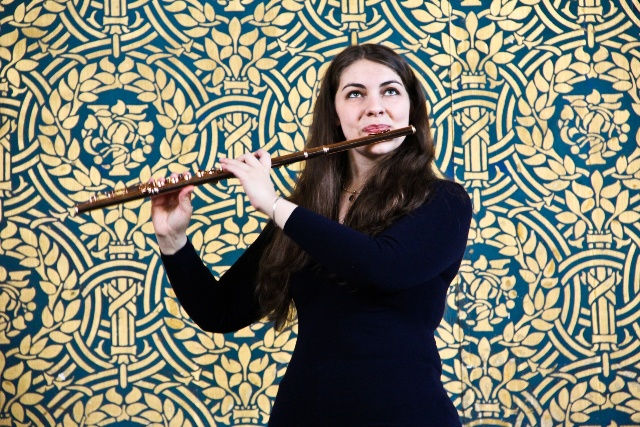
Ginevra
Petrucci
Flute
www.ginevrapetrucci.com
[...] Twenty year-old Ginevra Petrucci
has impressive credentials, studying with a who's who of the international flute world and accumulating a bunch of awards. She is an ideal for this material, displaying a lovely sound and the required virtuosity. And she phrases beautifully, with a legato worthy of a great singer and an elegant sense of rubato. It is a pleasure to listen to such a young player perform without affectation and with such a mature sense of style.
[...]
John Wion, The flutist quarterly
BIOGRAPHY
Praised by the Italian press as being “one of the most interesting talents of her generation”, and described as having “a beautiful phrasing, brilliant virtuosity and a legato worthy of a great singer” by The Flutist Quarterly, Ginevra Petrucci is an internationally renowned musician with a dynamic performance schedule. Her concert diary has led her to perform in some of the most prestigious concert halls throughout Europe, the United States, Japan, Brazil, Israel, Turkey and Africa, alongside acclaimed artists, that including pianist Bruno Canino, a regular collaborator, harpist Emmanuel Ceysson, and harpsichordist Jory Vinikour.
An active chamber musician, she collaborates with ensembles such as I Virtuosi Italiani, I Musici di Roma and the Kodály Quartet.
Her recordings include Giulio Briccialdi’s four Flute Concerti with I Virtuosi Italiani (first world recording, Bongiovanni 2009), the complete Flute Duets by Joseph Haydn (to be issued in 2014) and the complete Quintets by Friedrich Kuhlau with the Kodály Quartet (Brilliant Classics 2013).
As principal flute of the Yale Philharmonia Orchestra, the Yale Baroque Ensemble and the Chamber Orchestra of New York, she has played with world renown conductors in many of the most important concert halls of the american East coast.
She is a funding member of the Delphi Chamber Orchestra and of the chamber group Cantata Profana, both based in the United States. She has been visiting professor and has presented masterclasses and lecture-recitals at Accademia Flatus (Sion, Switzerland), Académie Musicale de Villecroze (France) and Accademia Musicale Sherazade (Roma). Since 2013, she is Professor at the Accademia Angelica Costantiniana of Rome and at the European Culture and Performing Arts Association of Tokyo.
As a strong advocate of modern and contemporary music, she had direct collaborations with composers Kaija Saariaho, Steve Reich, George Crumb, Betsy Jolas and Jean-Michel Damase, as well as with several composers of her generation both in the United States and in Italy, where she is collaborating with Nuova Consonanza Contemporary Music Festival and La Biennale di Venezia.
Born in Rome (Italy) in 1989, she studied at Conservatorio ‘Santa Cecilia’ of Rome with her father, to continue her education at Ecole Normale ‘Alfred Cortot’ with Pierre-Yves Artaud. She holds a Master of Music and an Artist Diploma at the Yale University, where she studied with Ransom Wilson.
In 2012 she was named the recipient of the The Thomas Daniel Nyfenger Prize for highest standard of excellence in woodwind playing by the Yale University. Among her most recent engagements are an international recital tour for Verdi and Wagner's anniversary, that reached seven countries between Europe and Asia, and her Carnegie Hall debut with Bruno Canino.
VIDEOS
PHOTOS






REVIEWS
"I tre Quintetti con flauto di Friedrich Kuhlau (1786-1832) sono validi modelli del ”Biedermeier” in musica. Non è solo un movimento artistico, ma è sicuramente vero che intorno agli anni venti dell’Ottocento (siamo nel 1823) comincia a profilarsi, prima nei paesi di lingua tedesca e poi in tutta l’Europa e l’America del Nord, una tendenza all’aurea mediocritas nelle forme del vivere quotidiano sotto forma di arredo della casa, dilagando poi nell’assetto generale delle arti. Il Biedermeier è l’estetica della vita borghese ai suoi livelli più alti di benessere e consapevolezza, tali da espungere o almeno ridimensionare la tensione romantica o lo scetticismo del negativo.
Beethoven, che del romanticismo musicale è forse l’esponente per antonomasia, ebbe un incontro divertente e sintomatico con Kuhlau che le fonti ricordano. A Baden durante una cena Kuhlau offrì a Beethoven un canone sul nome Bach (a ogni lettera corrisponde una nota) e Beethoven il giorno dopo lo ripagò mandandogli un canone sul cognome Kuhlau. Era uno scherzo perché le parole dicono Kuhl nicht Lau, cioè, ironizzando sul nome, Kuhl freddo, nicht non, Lau tiepido. In altri termini è probabile che Beethoven volesse scherzare su Kuhlau, come tipico esponente di un’arte che a lui non faceva né caldo né freddo. È, paradossalmente, una caratteristica del Biedermeier musicale, il che non vuol dire che si tratti di un’arte insignificante o mediocre.
L’aurea mediocritas, nel senso dei nostri classici latini, significava soltanto la discrezione dell’enunciato dell’opera d’arte, che non si avventura più nei territori non ammessi dalla nuova mentalità borghese, convinta di essere in grado di definire ciò che è arte e ciò che non lo è. Non esce, cioè, dai limiti del decoro e non entra nei meandri dell’angoscia, dell’ironia, della satira, dell’iperbole. Lette in questa ottica le composizioni di Kuhlau sono in effetti di grande interesse e di fine fattura. Le interpreta qui una flautista veramente brillante come Ginevra Petrucci con il superbo Kodály Quartet."
Claudio Strinati, Il Venerdì di Repubblica
"Nel ventennale della scomparsa di Severino Gazzelloni, lo storico gruppo d'archi I Musici rende omaggio all'indimenticato "Flauto d'Oro" con un concerto che vede come solista la giovane Ginevra Petrucci, uno dei più interessanti talenti della nuova generazione [...]"
La Repubblica
"[...] quanto finora descritto si ritrova pienamente nell’esecuzione di Ginevra Petrucci e de “I Virtuosi Italiani”, con la prima che, proseguendo la tradizione di famiglia [...]dimostra di avere raggiunto una notevole maturità, che le permette di affrontare i numerosi passaggi virtuosistici, rilasciando un suono di grande nitidezza. Dal canto suo, l’ensemble orchestrale, forte di un’esperienza ventennale, presenta solidità, compattezza ed un ottimo affiatamento, sia nel proprio ambito che con la solista, risultando il partner ideale per la giovanissima flautista. [...]"
Marco Del Vaglio, Critica di musica classica